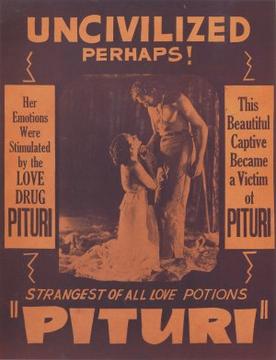Related Research Articles

Jedda, released in the UK as Jedda the Uncivilised, is a 1955 Australian film written, produced and directed by Charles Chauvel. His last film, it is notable for being the first to star two Aboriginal actors, Robert Tudawali and Ngarla Kunoth in the leading roles. It was also the first Australian feature film to be shot in colour.

Cinesound Productions Pty Ltd was an Australian feature film production company. Established in June 1931, Cinesound developed out of a group of companies centred on Greater Union Theatres that covered all facets of the film process, from production to distribution and exhibition. Cinesound Productions established a film studio as a subsidiary of Greater Union Theatres Pty Ltd based on the Hollywood model. The first production was On Our Selection (1932), which was an enormous financial success.

In the Wake of the Bounty (1933) is an Australian film directed by Charles Chauvel about the 1789 Mutiny on the Bounty. It is notable as the screen debut of Errol Flynn, playing Fletcher Christian. The film preceded MGM's more famous Mutiny on the Bounty, starring Charles Laughton and Clark Gable, by two years.

Uncivilised is a 1936 Australian film directed by Charles Chauvel. It was an attempt by Chauvel to make a more obviously commercial film, and was clearly influenced by Tarzan.

Heritage is a 1935 Australian historical film directed by Charles Chauvel.

Rangle River is a 1936 Australian Western film directed by Clarence G. Badger based on a story by Zane Grey.
Clara Gibbings is a 1934 Australian film directed by F.W. Thring about the owner of a London pub who discovers she is the daughter of an earl. It was a vehicle for stage star Dorothy Brunton.

Trooper O'Brien is a 1928 Australian silent film from the team of John and Agnes Gavin. It was a melodrama set during the "Ned Kelly era" about an orphaned girl raised by a policeman in the bush. It is one of the rare early Australian films that still exist in its entirety.

The Bushwhackers is a 1925 Australian silent film directed by Raymond Longford loosely based on Alfred Tennyson's 1864 poem Enoch Arden. It is considered a lost film.
The Man They Could Not Hang is a 1934 Australian film directed by Raymond Longford about the life of John Babbacombe Lee, whose story had been filmed previously in 1912 and 1921.
The Birth of White Australia is a 1928 Australian silent film directed by Phil K. Walsh. It is an historical drama about the settlement of white Australia, including scenes of Captain Cook's landing at Botany Bay, skirmishes with Australian Aborigines and the Lambing Flat riots. This was Australia's last silent feature film, thanks to the advent of "talkies".
When the Kellys Rode is a 1934 Australian film directed by Harry Southwell about Ned Kelly.
The Adorable Outcast is a 1928 Australian silent film directed by Norman Dawn about an adventurer who romances an island girl. The script was based on Beatrice Grimshaw's novel Conn of the Coral Seas. It was one of the most expensive films made in Australia until that time, and was Dawn's follow up to For the Term of His Natural Life (1927). It did not perform as well at the box office and helped cause Australasian Films to abandon feature film production.
The Menace is a 1928 Australian silent film about the drug trade in Sydney. It is considered a lost film.

The Romance of Runnibede is a 1928 Australian silent film based on an incident in a book by Steele Rudd. Unlike many Australian silent movies, a copy of it exists today.
Tall Timber is a 1926 Australian silent film about a rich man who flees the city and works in a timber mill. It is considered a lost film.

Captain Midnight, the Bush King is a 1911 Australian silent Western film about the fictitious bushranger Captain Midnight. It was the directorial debut of actor Alfred Rolfe. The film is based on the play of same name by W. J. Lincoln and Alfred Dampier. Captain Midnight, the Bush King is now considered lost.
The Monk and the Woman is a 1917 Australian silent film directed by Franklyn Barrett. It is considered to be lost.

The Haunted Barn is a short 1931 Australian comedy film produced by F.W. Thring directed by Gregan McMahon. It was one of the first productions by Thring's Efftee Studios. The film was produced to support of the feature Diggers (1931) and shown on the same bill.
Lyndon Raymond Dadswell was an Australian artist, remembered as the country's first official war sculptor.
References
- 1 2 Andrew Pike and Ross Cooper, Australian Film 1900–1977: A Guide to Feature Film Production, Melbourne: Oxford University Press, 1998, p147
- ↑ "Company News". The Sydney Morning Herald . National Library of Australia. 2 December 1927. p. 15. Retrieved 7 August 2012.
- ↑ "Australasian Productions of the Year.", Everyones., Sydney: Everyones Ltd, 12 December 1928, nla.obj-590190880, retrieved 13 August 2024– via Trove
- ↑ "Advertising". The Sunday Times . Perth: National Library of Australia. 29 July 1928. p. 8 Section: First Section. Retrieved 7 August 2012.
- 1 2 Jan Roberts (2018). "Elsa Antoinette Jacoby (1910–1994)". Australian Dictionary of Biography: Jacoby, Elsa Antoinette (1910–1994). National Centre of Biography, Australian National University. Retrieved 1 November 2023.
- ↑ "AUSTRALIAN FILM". The Sydney Morning Herald . National Library of Australia. 8 February 1930. p. 17. Retrieved 7 August 2012.
- ↑ Jane Landman, The Tread of a White Man's Foot, Canberra: Pandanus Books (The Australian National University), 2006, p. 45.
- ↑ Jane Landman, The Tread of a White Man's Foot, Canberra: Pandanus Books (The Australian National University), 2006, p. 41.